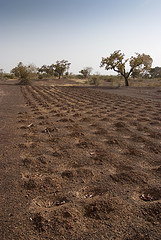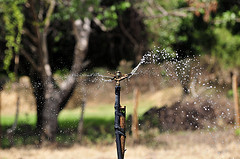Author courtesy: India.CarbonOutlook
Image courtesy: TREEAID and CIAT International Center for Tropical Agriculture
Author: Shreema Mehta
Shreema Mehta, working on conservation biology and policy at the University of Maryland and TERI discusses the potential of rainwater harvesting from a sustainable agriculture perspective.

The numbers that measure the economic behemoth that is Indian agriculture cannot help but inspire. Driven mostly by smallholder farmers who must rely only on erratic rainfall to nourish their crops, Indian farmers feed not just the country’s population of 1.2 billion people, but through exports, significant part of the rest of the world as well. In 2008, India produced 150 million megatons of rice, and 31 million megatons of wheat. Despite having only 3 percent of the Earth’s land, India is the world’s largest producer of pulses, spices, and tropical fruits, among other goods.
But to achieve these numbers, farmers and agricultural policymakers have come to rely on practices that are not sustainable. Perhaps the most troubling practice is the irrigation of crops using groundwater, which is being depleted at an alarming rate. Because of unchecked groundwater exploitation, a nation whose cities get flooded every monsoon season also faces an acute water crisis.
In response, farmers, NGOs and state agencies are increasingly turning to rainwater harvesting to make use of runoff and reduce dependence on slowly dwindling groundwater. To help ensure farmers have enough water to feed a growing population, this practice in sustainability practice ought to be scaled up and mainstreamed in India’s cities, towns and villages.

In the past, before the modern era of commercialized, often irrigated agriculture, farmers in India had come up with an ingenious range of methods to store rainwater for later use. In Southern India, farmers built a network of small underground tanks that were covered with earthen dams to store runoff. The tanks would form a chain, so that surplus water would spill into tanks below. Water in the deepest tanks was used during times of drought.
Farmers in the rest of the country, from Madhya Pradesh to Rajasthan, also adopted similar tank methods, or built ponds, reservoirs and dams to store water. Though these reservoirs / tanks have different names and origins, their purpose has been the same: Capture as much of the monsoon rainfall as possible to ensure a water supply for the dry season and protection against drought.
But nowadays, most such systems are in disrepair. Urban and industrial development has paved over many such systems. Those that are still accessible may be broken, or have accumulated sediment that makes any water they store unusable.
Many NGOs around the country, such as WASSAN, Pradan or the Sadguru Development Foundation, are leading the way in bringing back rainwater harvesting to the nation’s farms. In addition, in its policy statements, the national government recognizes that rainwater harvesting is a valuable tool to conserve water resources and adapt to climate change.

In agriculture circles, many academics, NGO and government officials call for a “second Green Revolution,” which this time strives for improved productivity, but in a way that sustains natural resources for future generations. Rainwater harvesting ought to be a primary step in this new revolution in sustainable agriculture.
/articles/rainwater-harvesting-need-not-be-obscure-sustainability-measure